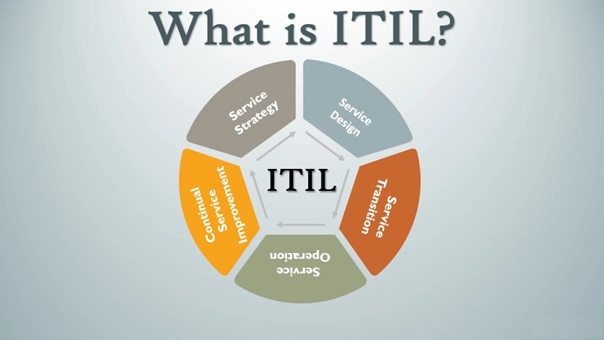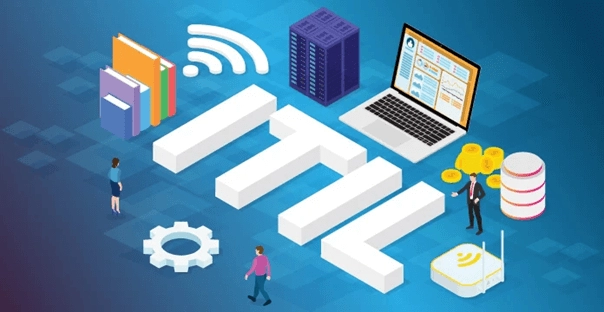What is ITIL? A Guide to the IT Infrastructure Library
ITIL, which stands for Information Technology Infrastructure Library, originally meant the infrastructure library of information technology and refers to a set of detailed practices for activities in the field of information technology, such as information technology service management (ITSM) and information technology asset management (ITAM). Has it? This series focuses on aligning IT services with the needs of businesses and learning it is critical for those involved in this field. In this article, we are with you with ITIL training, and we will talk about this library’s history, benefits, and applications.
ITIL describes processes, procedures, tasks, and checklists that are neither organization-specific nor technology-specific but can be applied by organizations to create the strategy, deliver value, and maintain a high level of competency. ITIL allows organizations to deliver a project as planned. Although ITIL underlies ISO/IEC 20000 – the international service management standard for information technology service management – there are fundamental differences between ISO 20000 and the ITIL framework.
History of ITIL
Before going to the ITIL training, it is not bad to get acquainted with the history of this library; What we call the infrastructure library of information technology today was developed by the CCTA – Central Computer and Telecommunication Agency – and was initially known as the Government Information Technology Infrastructure Management Methodology – Government Information Technology Infrastructure Management Methodology.

ITIL was followed by other successful practices such as ISPL, ASL, DSDM, and CMMI and is mainly linked to government (i.e., government-affiliated) IT institutions by COBIT. In late 2005, the Open Source Geospatial Consortium (OGC) revised ITIL, which resulted in ITIL version three, and the library was finally made publicly available in 2007. The ITIL v3 version has five principles:
- Service Strategy – Service Strategy
- Service Operation – Service Operation
- Service Design – Service Design
- Service Transition – Service Transition
- Continuous Service Improvement – Continual Service Improvement
These five principles updated many of the points of ITIL version two and developed the scope and scope of ITIL activities in service management.
Why is ITIL training important?
Because ITIL provides a collection of best scientific practices from around the world (in IT service management) to IT engineers and managers, learning it is critical. ITIL training has several basic advantages that you will get to know below:
- Better familiarity with concepts related to information technology management
- Find a broad view of the operations that an IT manager must perform
- Learning standard concepts in the field of information technology in the world-class
To get to know more and to learn ITIL, we offer the training of ITIL Processes – Service Operations on the course website, which is provided to you comprehensively and completely free of charge:
The general information technology infrastructure library version 3
As we mentioned before, ITIL version 3 has five very important principles; this section will examine each of them.

Service Strategy
Strategy or service strategy is the centerpiece of ITIL; however, it cannot work alone and without other IT departments. This section results from a framework for creating a successful experience (Best Practices) resulting from a long-term service strategy development. This section has different topics:
- General Strategy
- Competition and Market Space
- Service Provider Types
- Service Management as a Strategic Asset
- Organization Design and Development
- Key Process Activities
- Financial Management
- Stock service management (Service Portfolio Management)
- and key roles and responsibilities of staff engaging in service strategy
Service design
IT service design derives from successful experiences and includes the design of architecture, processes, rules, documentation, and consideration of future business requirements and includes the following topics:
- Service Design Package (SDP – Service Design Package)
- Service Catalog Management
- Service Level Management
- Designing for Capacity Management
- Continuous IT service (IT Service Continuity)
- Information Security
- Supplier management
- and key roles and responsibilities for staff engaging in service design

Service transfer
Service delivery is related to delivering services that require active/operational business and mainly follow the IT project sector rather than a conventional business. This section also includes various topics:
- Managing changes to the “BAU” environment
- Service Asset
- Configuration Management
- Transition Planning and Support
- Release and Deployment Management
- Change Management
- Knowledge Management
- Key Roles of Staff Engaging in Service Transition
Service operation
Acquiring successful experiences lies in delivering Agreed Levels services to end users and customers. Also, in service operations (which is an important part of ITIL training), monitoring problems and establishing a balance between reliable service, cost, etc. is important, and this part of ITIL includes the following parts:
- Balancing conflicting objectives, such as reliability and cost, etc
- Incident Management
- Event Fulfillment
- Event Management
- Event Management
- Event Management
- Service Desk
- Technical and Application Management
- key roles and responsibilities for staff engaging in service operation

continuous improvement of the Service; As the final part of the ITIL training
Continual refinement and improvement of IT services are carried out in response to changing business needs, as stability and lack of progress will degrade the organization. Continuous service improvement refers to changing business needs by defining and implementing improvements in information technology services that support business processes.
Mikrotik’s role in better user management
In the continuation of the ITIL training topic, we should look at Mikrotik products and their applications in the field of information technology. The main product of this company is a Linux-based operating system called MikroTik RouterOS, and by installing it on the company’s dedicated hardware, RouterBOARD turns your system into a network router. Firewall, virtual private network (VPN) service provider and client, shaping and improving the quality of broadband services and access point features are among Mikrotik’s various services.
To improve Mikrotik’s performance level, it is necessary to train it and purchase a license. This company’s executive program for the Windows operating system is called inbox and provides users with a graphical interface to configure the router and monitor its operation. In addition, RouterOS provides access via Telnet, FTP, and SSH and an Application Programming Interface (API) for direct application access for management and monitoring.
Features that make Mikrotik special
Special features in Mikrotik have made this company’s products one of the most popular in the field of information technology and networking. One of these features is microbic stability; Like a powerful router, the Mikrotik router has high boot speed and automatic operation – no login required. The high speed of installing settings is one of its special features, which can be installed within a few minutes, and settings can be imported or exported from or to other devices.
But the most important and special feature of Mikrotik is its cost-effectiveness compared to similar hardware samples; By passing Mikrotik training courses and how to use it, you will gain the necessary experience to install and operate all Mikrotik equipment.

What are the uses of Mikrotik routing?
Using Mikrotik as a router is one of its main uses; In many networks, it is necessary to convert it into several smaller networks. On the other hand, when you have several offices, branches and agencies, you will need a router to communicate between them. Mikretik supports all protocols for routing – Telnet, SSH, etc.
Communicating between offices is an important issue in the network field, and Mikrotik is very useful. You can easily create a VPN connection between your branches to establish a secure connection and use the information resources available between the branches, such as file sharing, printers, cameras, programs, etc., with the possibility of access restrictions.
Bandwidth management using Mikrotik
Controlling the internet usage of employees and users and dividing the use of each system is one of the most important issues facing network managers. The ability to limit and manage internal (LAN) and external (Internet) bandwidth is another feature that Mikrotik provides to the administrator. As a network administrator, you can manage a group of users and even IPs by origin, destination, port, and program type.
Professional Mikrotik Setup, which requires comprehensive training, allows you to control all activities on the network; You can have multiple Internet subscriptions and assign each subscription to specific users as needed.
Creating the highest level of safety using Mikrotik
With the help of Mikrotik firewalls, you can limit the outgoing and incoming ports of the network. Also, by publishing the cameras in the network and changing their ports, you will be able to see the status of the cameras through the Internet and where you have access to the Internet, even through mobile phones. Users can communicate with resources within the network through the Internet. By creating a VPN server, it is possible to connect the company’s employees to the internal network at any place and time (at home and while traveling).
Kserver
User management training with Mikrotik; why and how
Due to the unique acceptance of network hardware by organizations, companies, and even small businesses, as well as the assortment of resources and users, including Internet access, users’ access to network information such as printers, emails, and automation, limited access should be provided to each network user. This requires permanent management of users comprehensively.
As you have read so far, one platform that meets all your needs in terms of user management is the use of Mikrotik routers, which are used in most organizations without the need for a new physical server. User management training with Mikrotik should include the following to give you everything you need to know about Mikrotik:
- Getting to know Mikrotik and its competitors
- Learning how to work with VMware Workstation
- Getting to know Mikrotik Hotspot
- Mikrotik installation tutorial
- Review of different microbic fevers
- Doing some examples and presenting different scenarios in the real world
- Setting up Tunnels and VoIP
- Training to assign profiles to different users
Network Plus; If you are interested in computer networks
Network Plus is the alphabet of computer networks, and it means that if you plan to make money in this field, it is necessary to pass Network Plus in the first place. Unlike other computer courses, there is no need for knowledge of mathematics in network and Network Plus, and you can pass the Network Plus course without it. In this tutorial, you will get to know the basic principles of the network:
- Familiarity with network concepts
- Network topology
- Geographically and logically divide the network
- OSI and TCP/IP models
- IP Address
- A full introduction to CMD
- Security in computer networks
It has created a new platform for the development of individuals and societies, and without a doubt, network training can be one of the main specializations in information technology. The necessity of training people who are experts in the network is felt more and more in today’s society despite the vast extent and size of the use of the network. The network plus extracurricular course is exactly what is recommended to all people related to information technology:
Creating security in the network is more important than setting it up.
It is rare to find a week in which there is no news about hackers tampering with computer systems and networks. With the expansion of cable, wireless, simple, and complex networks, many organizations have been attacked by hackers due to not paying attention to safety principles in creating their internal networks and have surrendered their valuable information and assets to them.
Many companies implement various methods to create security in their internal network, which slows down the network. There is no need to use different software and protocols to establish security in the network. Still, high levels of security can be achieved with the lowest amount of server occupancy. This work requires acquiring a lot of knowledge and experience in creating security in computer networks.
In the Faradras computer network security training course, you will learn everything related to maintaining network security and will be tested in several real-world scenarios.
The importance of web penetration testing and coping strategies
Web Penetration Testing is a simulated cyber attack performed against your computer to check possible system vulnerabilities. The steps of penetration testing must be done under the supervision of an expert because someone may destroy your information.
Many organizations hire penetration testing experts to ensure the safety level of their networks and websites. Suppose a flaw in web security is revealed as a result of the penetration test. In that case, the expert not only reports it but can improve the organization’s security in the cyber world. Other advantages of web penetration testing include the following examples:
- Identifying and prioritizing security risks to fix them
- Managing weaknesses as best as possible
- Adopting security approaches before cyber attacks
- Approving security programs and discovering web and network strengths
Teaching penetration testing on the web and ways to deal with it
To become an expert in web penetration testing and how to deal with it, it is very important to acquire the necessary technical knowledge and skills; From basic web protocol definitions and security definitions to CSRF vulnerabilities and SQL injection, everything should be taught to you according to principles.

